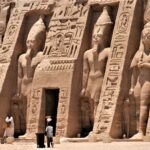Introduction
Egypt, a land steeped in ancient mystique and vibrant modernity, beckons travelers from across the globe to explore its treasures. From the timeless allure of the pyramids to the bustling markets of Cairo, the tapestry of Egyptian culture is rich and diverse. As a tourist, immersing yourself in this cultural kaleidoscope can elevate your experience, fostering a deeper connection with the people and the heritage that defines this enchanting destination.
Understanding Egyptian culture is not merely a matter of etiquette; it is a gateway to unlocking the heart of this historic nation. Whether you are navigating the labyrinthine streets of Old Cairo, marveling at the grandeur of Luxor’s temples, or savoring the flavors of traditional dishes, cultural awareness enhances every facet of your journey.
This article serves as a guide for those seeking to unravel the intricacies of Egyptian culture, offering insights and practical tips to ensure a respectful and enriching exploration of this captivating destination. Join us on a journey that goes beyond sightseeing, inviting you to embrace the essence of Egypt and forge meaningful connections with its people.
Historical and Cultural Background

II. Historical and Cultural Background
Egypt, an ancient cradle of civilization, invites visitors to traverse through the corridors of time, unraveling a tapestry woven with thousands of years of history and cultural richness. At the heart of this journey stands the iconic Giza Plateau, home to the Great Pyramid, a masterpiece of ancient engineering. The pyramids, including the enigmatic Sphinx, are enduring symbols of ancient Egyptian ingenuity, inspiring awe and speculation regarding their construction and purpose.
The pharaonic era, marked by divine rulers known as pharaohs, showcases a society deeply rooted in religion and mythology. Different dynasties contributed significantly to art, science, and governance, leaving behind an indelible legacy. Luxor, once the ancient city of Thebes, bears witness to this legacy with its grand temples. Luxor Temple, a majestic structure dedicated to the divine, and the sprawling Karnak Complex, a vast network of temples and chapels, provide glimpses into the religious and political life of ancient Egypt. The Valley of the Kings, nestled on the west bank of the Nile, serves as the eternal resting place for pharaohs and dignitaries, adorned with elaborate tombs and intricate hieroglyphics.
Egypt’s historical narrative extends beyond its indigenous roots, with the Greco-Roman period introducing Hellenistic and Roman influences. The captivating story of Cleopatra and her interactions with Roman leaders is interwoven with the enduring legacy of Greco-Roman art and architecture, evident in structures like the Temple of Kom Ombo. The subsequent Islamic era brought a fusion of cultural and architectural elements, with mosques and religious monuments becoming integral to the Egyptian landscape. Islamic art and calligraphy further enriched the cultural expression of the nation.
The Ottoman and colonial eras left their imprints on Egypt, shaping its governance and society. Ottoman rule influenced Egyptian politics, while British and French colonial interests in the 19th and 20th centuries left a lasting impact. Amidst external influences, Egypt cultivated a distinct identity, setting the stage for a vibrant nationalist movement. Independence was achieved, and the Republic of Egypt emerged, underlining a pivotal chapter in the nation’s modern history.
The mid-20th century marked a period of political and cultural renaissance under President Gamal Abdel Nasser. Economic and social reforms aimed at modernization were coupled with efforts to revitalize Egyptian culture and promote Arab identity. The post-Nasser era saw the unfolding of globalization, as contemporary influences began to shape Egypt’s popular culture. In the face of rapid technological advancements and global connectivity, Egypt continues to navigate the delicate balance between tradition and modernity.
Exploring this historical and cultural background becomes a compass for tourists, guiding them through the layers of Egypt’s rich heritage. From ancient wonders to the echoes of modernization, each chapter in Egypt’s story contributes to the diverse and captivating cultural mosaic that awaits those who seek to understand and appreciate it.
Social Customs and Etiquette
III. Social Customs and Etiquette
Understanding the social customs and etiquette of Egypt is paramount for visitors seeking to engage with locals respectfully and embrace the nuances of daily life. Navigating social interactions in Egypt involves acknowledging traditional values and adhering to cultural norms.
A. Greetings and Expressions of Politeness
In Egypt, greetings are a vital part of social interactions. Handshakes are common between individuals of the same gender, accompanied by verbal exchanges of pleasantries. However, opposite genders often refrain from physical contact in public. It is customary to address people using titles such as “Mr.” or “Mrs.” followed by their last name. Expressions of politeness, such as “please” and “thank you,” are appreciated and contribute to a positive social atmosphere.
B. Respect for Traditional Values and Family
Family holds significant importance in Egyptian society, and respecting familial ties is crucial. It is common for extended families to live in close proximity, fostering strong bonds and communal support. When engaging with locals, showing interest in their family and expressing admiration for cultural values related to family life can create meaningful connections. It’s advisable to avoid sensitive topics related to family matters or personal affairs unless the conversation naturally leads in that direction.
C. Appropriate Behavior in Public Spaces and Religious Sites
Public spaces in Egypt are often vibrant and bustling, and there are certain behaviors that visitors should observe. Dressing modestly, particularly in religious sites, is essential to show respect for Islamic traditions. It is customary to remove shoes before entering someone’s home, and the same practice applies in certain traditional establishments. Additionally, public displays of affection should be kept to a minimum, as they may be considered inappropriate.
Visiting religious sites requires a heightened level of cultural sensitivity. Dressing modestly, covering shoulders and knees, and removing footwear before entering mosques are standard practices. Silence and a respectful demeanor are expected in religious spaces, and photography may be restricted in certain areas. Observing these customs demonstrates a genuine appreciation for the religious and cultural significance of these sites.
Understanding and embracing the social customs and etiquette of Egypt fosters positive interactions, allowing visitors to connect with locals on a deeper level and ensuring a more enriching cultural experience. By demonstrating respect for traditional values and adhering to established norms, tourists can navigate social situations with grace and openness, ultimately contributing to a harmonious and enjoyable stay in this captivating country.
Cuisine and Dining Etiquette

IV. Cuisine and Dining Etiquette
Egyptian cuisine is a flavorful tapestry that reflects the country’s rich history and diverse cultural influences. Exploring the local dishes and understanding dining etiquette is not only a culinary adventure but also a cultural immersion that enhances the overall travel experience.
A. Overview of Traditional Egyptian Dishes
Egyptian cuisine is characterized by a harmonious blend of spices, herbs, and fresh ingredients. Staple foods include bread, rice, and legumes, while dishes often feature lamb, chicken, and fish. Some iconic dishes include:
- Koshari: A hearty mix of rice, lentils, and pasta topped with a spiced tomato sauce and crispy fried onions.
- Ful Medames: Mashed fava beans seasoned with olive oil, garlic, and various spices.
- Molokhia: A green soup made from the leaves of the molokhia plant, typically served with rice or bread.
B. Importance of Communal Dining
Dining in Egypt is a communal experience, with family and friends often gathering to share meals. Traditional Egyptian meals are served family-style, where multiple dishes are placed on the table, and everyone helps themselves. This communal approach fosters a sense of unity and hospitality. Visitors are encouraged to embrace this tradition, sharing dishes and engaging in conversation during meals.
C. Dining Etiquette and Cultural Norms
- Use of Right Hand: Traditionally, the left hand is considered less clean, so it’s customary to eat and pass items with the right hand.
- Communal Bread: Bread is a fundamental element of Egyptian meals. It is often torn into pieces and used to scoop up food. It is polite to break bread rather than cut it with a knife.
- Respecting Host Offers: If invited to someone’s home, it is customary to accept offers of food and drinks. Declining multiple times may be seen as a sign of politeness, so a gracious acceptance is appreciated.
- Tea Culture: Tea is a significant part of Egyptian hospitality. If offered tea, it’s customary to accept, even if it’s a small gesture.
- Tipping Practices: Tipping is a common practice in restaurants and cafes. A service charge may be included, but an additional tip is appreciated for good service.
By delving into the culinary delights of Egypt and embracing dining etiquette, tourists not only savor the flavors of the country but also connect with the warmth and generosity of the Egyptian people. Engaging in communal dining experiences becomes a gateway to understanding the cultural significance of food and the role it plays in fostering connections among friends and family.
Dress Code and Modesty

V. Dress Code and Modesty
Understanding and respecting the dress code and notions of modesty in Egypt are crucial aspects of cultural sensitivity for tourists. As a predominantly Islamic country, Egypt has specific expectations regarding clothing, particularly in public and religious spaces.
A. Appropriate Clothing for Different Occasions
- Everyday Attire: In urban areas, such as Cairo and Alexandria, casual Western-style clothing is generally acceptable. However, it’s advisable to dress modestly to show respect for local customs and traditions.
- Religious Sites: When visiting mosques or religious sites, both men and women should dress modestly. Women are expected to cover their heads, shoulders, and knees, while men should avoid wearing shorts. It’s common for women to carry a scarf or shawl to cover their heads when entering religious spaces.
B. Respect for Islamic Traditions in Clothing
- Women’s Attire: Women are commonly seen wearing long skirts or trousers, loose-fitting tops with sleeves, and a headscarf. While it’s not a strict requirement for non-Muslim women to cover their hair, it’s a sign of cultural respect to do so in certain situations.
- Men’s Attire: Men typically wear long trousers and shirts with sleeves. While short sleeves are generally acceptable, it’s advisable to avoid overly casual or beachwear attire in public places.
C. Understanding Local Sensitivities Regarding Dress
- Beach Resorts: While beach resorts and tourist areas are more lenient in terms of dress code, it’s still respectful to cover up when leaving these designated areas.
- Rural Areas and Traditional Settings: In more conservative or rural areas, locals may adhere to stricter dress codes. Tourists should adapt their attire accordingly to avoid any unintended cultural misunderstandings.
By aligning their attire with local expectations, tourists demonstrate cultural awareness and respect. Embracing modest dress not only facilitates a more positive interaction with the local community but also enhances the overall cultural experience by fostering a sense of harmony and mutual understanding.
Language and Communication
VI. Language and Communication
Navigating the linguistic landscape is a key element in fostering meaningful connections during your visit to Egypt. While Arabic is the official language, English is widely understood in tourist areas. However, making an effort to learn a few Arabic phrases and understanding the nuances of communication enhances the overall cultural experience.
A. Common Arabic Phrases for Tourists
- Greetings:
- As-salamu alaykum (Peace be upon you) – Common Islamic greeting
- Ahlan wa sahlan (Welcome) – General welcome greeting
- Polite Expressions:
- Shukran (Thank you) – Expressing gratitude
- Afwan (You’re welcome) – Response to expressions of gratitude
- Basic Phrases:
- Na’am (Yes) and La (No) – Simple affirmations and negations
- Min fadlak (Please) – Polite request
B. Importance of Non-Verbal Communication
- Hand Gestures:
- Handshakes are common, but it’s essential to be aware of the cultural context. Same-gender handshakes are typical, while opposite genders may not engage in physical contact.
- Eye Contact:
- Maintaining eye contact is generally acceptable, but prolonged eye contact may be perceived as impolite. In more conservative settings, people may avoid direct eye contact as a sign of respect.
C. Respectful Communication in a Diverse Cultural Context
- Use of Titles:
- Addressing individuals with appropriate titles such as “Mr.” or “Mrs.” followed by their last name is a sign of respect.
- Understanding Social Hierarchy:
- Respect for age and social status is crucial. Older individuals are often accorded deference, and it’s common to greet elders first in a group setting.
- Adapting to Conversational Styles:
- Egyptians are known for their friendly and warm communication style. Engaging in small talk and expressing genuine interest in the well-being of others is appreciated.
Cultivating an understanding of the local language and communication norms allows tourists to bridge cultural gaps and build rapport with locals. While English is widely used, making an effort to speak basic Arabic phrases demonstrates respect for the local culture and often elicits a positive response from the community. Communication becomes a bridge that connects travelers with the heart and soul of Egypt.
Religious Sensitivities

VII. Religious Sensitivities
As a predominantly Islamic country, Egypt holds deep religious significance, and tourists should approach religious sites and practices with the utmost respect and sensitivity. Understanding the principles of Islam and adhering to specific guidelines ensures a more culturally enriching experience while avoiding inadvertent cultural misunderstandings.
A. Overview of Islam in Egypt
- Five Pillars of Islam:
- Understanding the basic tenets of Islam, including the declaration of faith, prayer, charity, fasting during Ramadan, and pilgrimage to Mecca, provides context for religious practices in Egypt.
- Islamic Calendar:
- Being aware of the Islamic calendar and significant religious events, such as Ramadan, Eid al-Fitr, and Eid al-Adha, allows tourists to plan their visits with cultural sensitivity.
B. Respecting Religious Practices and Traditions
- Dress Modestly:
- When entering religious sites, both men and women should dress modestly. Women are advised to cover their heads, shoulders, and knees, while men should avoid wearing shorts.
- Photography Guidelines:
- Respect the rules regarding photography in and around religious sites. In many mosques, photography may be restricted or prohibited in certain areas. Always ask for permission before taking pictures of individuals.
- Behavior in Religious Spaces:
- Maintain a respectful demeanor in mosques and other religious venues. Silence is generally observed, and visitors are expected to refrain from loud conversations or disruptive behavior.
C. Tips for Visiting Mosques and Other Religious Sites
- Remove Shoes:
- It is customary to remove shoes before entering mosques. Be prepared to follow this practice and keep socks handy.
- Non-Muslim Entry Restrictions:
- Non-Muslims are typically not allowed to enter the prayer areas of mosques. Respect any signs or guidelines indicating restricted access.
- Timing of Visits:
- Be mindful of prayer times when planning visits to mosques. During prayer times, mosques may be closed to non-Muslims.
By approaching religious aspects with cultural sensitivity, tourists can gain a deeper understanding of the integral role that Islam plays in Egyptian society. Respecting religious practices and traditions ensures a harmonious coexistence between visitors and the local community, fostering a more profound appreciation for the cultural and spiritual aspects of Egypt.
Festivals and Celebrations

VIII. Festivals and Celebrations
Egypt’s cultural tapestry is woven with vibrant threads of festivals and celebrations, offering tourists a unique lens into local traditions and the joyous spirit that defines these special occasions. These events provide an exceptional opportunity for visitors to witness the richness of Egyptian culture and participate respectfully in the festivities.
Overview of Major Festivals and Events
Eid al-Fitr, marking the end of Ramadan, emerges as a significant celebration with families coming together for prayers, feasts, and the exchange of gifts. The festive atmosphere permeates markets and public spaces, providing tourists with a chance to experience the joyous ambiance. Similarly, Eid al-Adha, or the Feast of Sacrifice, commemorates the willingness of Ibrahim to sacrifice his son. Families engage in animal sacrifices, share meat with the less fortunate, and partake in festive gatherings. Additionally, the ancient spring festival of Sham el-Nessim, celebrated after Coptic Christian Easter, involves picnics, outdoor activities, and the enjoyment of traditional foods.
Participating Respectfully in Cultural Celebrations
A key aspect of participating in festivals is dressing appropriately. Locals often don traditional clothing, and tourists are encouraged to dress modestly or embrace traditional attire to show respect for the cultural significance of the event. Public celebrations, including parades and communal activities, welcome tourists to join in the festivities, such as traditional dances or music, and share the joy with locals. Sampling festival foods adds a delightful culinary dimension to the cultural experience.
Embracing the Festive Spirit and Local Customs
Learning traditional dances and music is a wonderful way for tourists to engage with locals during festivals. Participating in group dances or observing religious observances, such as prayers or processions, should be done with respect and an awareness of not disrupting the solemnity of the activities. Gift-giving etiquette, particularly during festivals like Eid al-Fitr, involves the exchange of small gifts or sweets—a practice tourists can embrace to enhance their connection with the local community.
By respectfully participating in Egypt’s festivals and celebrations, tourists not only gain deeper insights into the cultural and religious fabric of the country but also contribute to the shared joy and camaraderie that define these special moments. It becomes an immersive cultural experience, allowing visitors to celebrate alongside locals and forge lasting memories of their time in Egypt.
Conclusion
XI. Conclusion
In the captivating journey through Egypt’s cultural tapestry, tourists find themselves immersed in a kaleidoscope of history, traditions, and vibrant celebrations. From the awe-inspiring ancient wonders to the warmth of everyday interactions, understanding and embracing Egyptian culture elevates the travel experience.
Exploring the historical and cultural background unveils the layers of Egypt’s rich heritage, where the echoes of the pharaohs harmonize with the influences of diverse civilizations. Social customs and etiquette guide visitors through meaningful interactions, fostering connections with locals and enriching the tapestry of their memories.
Culinary adventures bring the flavors of Egypt to life, while respecting dress codes and modesty ensures seamless integration into daily life. Language becomes a bridge, and communication styles become a reflection of the warmth and hospitality ingrained in Egyptian culture.
Respecting religious sensitivities opens the door to sacred spaces and deepens the appreciation for the role of Islam in shaping the nation. Festivals and celebrations provide a firsthand experience of the joyous spirit that binds communities together, inviting tourists to share in the cultural vibrancy.
As the journey concludes, tourists carry with them not just souvenirs but a profound connection to Egypt’s soul. By embracing cultural understanding, travelers become not just spectators but active participants in the story of Egypt—a story that transcends time and invites all who visit to become a part of its enduring narrative.




Leave a Reply